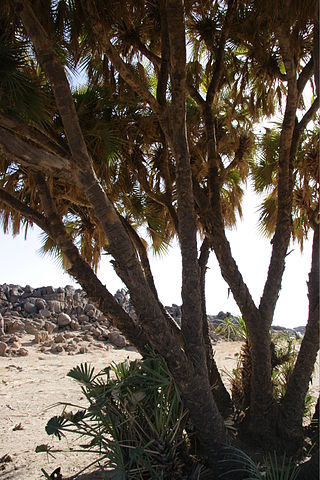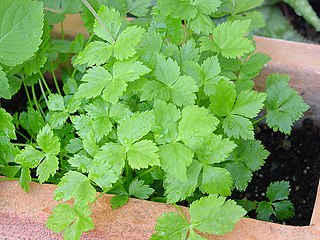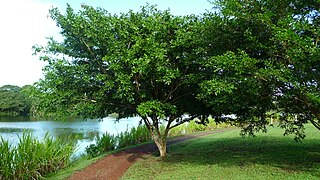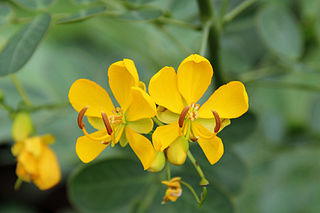
Impatiens is a genus of more than 1,000 species of flowering plants, widely distributed throughout the Northern Hemisphere and the tropics. Together with the genus Hydrocera, Impatiens make up the family Balsaminaceae.

Hyphaene is a genus of palms native to Africa, Madagascar, the Middle East, and the Indian subcontinent.

Senna spectabilis is a plant species of the legume family (Fabaceae) in the subfamily Caesalpinioideae native to South and Central America. They are often grown as an ornamental in front yards, parks, gardens, buildings etc. due to their bright yellow flowers that bloom during the summer months. They are also known as golden wonder tree, American cassia, popcorn tree, Cassia excelsa, golden shower tree or Archibald's cassia.

Guibourtia is a flowering plant genus in the family Fabaceae, also known by the common names as Rhodesian copalwood, African Rosewood, amazique, bubinga, kevazingo, and ovangkol.

Cryptotaenia, or honewort, is a genus of herbaceous perennial plants, native to North America, Africa, and eastern Asia, growing wild in moist, shady places.

Senna obtusifolia, known by the common names Chinese senna, American sicklepod, sicklepod, etc., is a plant in the genus Senna, sometimes separated in the monotypic genus Diallobus. It grows wild in North, Central, and South America, Asia, Africa, and Oceania, and is considered a particularly serious weed in many places. It has a long-standing history of confusion with Senna tora and that taxon in many sources actually refers to the present species.

Senna, the sennas, is a large genus of flowering plants in the legume family. This diverse genus is native throughout the tropics, with a small number of species in temperate regions. The number of species is estimated to be from about 260 to 350. The type species for the genus is Senna alexandrina. About 50 species of Senna are known in cultivation.
Monkey pod is a common name for several plants and may refer to:

Senna artemisioides, commonly known as wormwood senna, silver senna or silver cassia, is a species of flowering plant in the family Fabaceae and is endemic to Australia, where it is found in all mainland states and territories. It is a small, woody shrub with silver-green leaves and yellow flowers.

Zygia is a genus of flowering plants in the family Fabaceae. It belongs to the mimosoid clade of the subfamily Caesalpinioideae.

Senna bicapsularis is a species of the legume genus Senna, native to northern South America, from Panama south to Venezuela and Colombia, and also the West Indies. Common names include rambling senna, winter cassia, Christmas bush, money bush, and yellow candlewood. In Florida, Senna pendula is usually cultivated as, and misapplied to, S. bicapsularis.

Senna didymobotrya is a species of flowering plant in the legume family known by the common names African senna, popcorn senna, candelabra tree, and peanut butter cassia. It is native to Africa, where it can be found across the continent in several types of habitats.

Catopsilia florella, the African migrant, African emigrant, or common vagrant, is a butterfly of the family Pieridae. It is found in Africa, Arabia and the Canary Islands. Like Catopsilia pomona, this species also has a habit of migration.

Senna occidentalis [Indian vernacular name Usaya ki Fali] is a pantropical plant species, native to the Americas. The species was formerly placed in the genus Cassia.

Hyphaene petersiana, the real fan palm or makalani palm, is a palm tree native to the subtropical, low-lying regions of south central Africa.

Senna italica, the Port Royal senna, Italian senna, or Senegal senna is a legume tree in the genus Senna. It is recognized by many other common names based on the regions it grows in. In India, it is used to produce a powder for treating hair-related diseases which is known as “neutral henna”. Whereas, in some parts of the world, this species is cultivated for the leaves which yield the drug senna, known commonly as Senna glycoside, which in turn is the base for a laxative. Senegal senna is easily distinguishable through its many distinctive features. There are 3 subspecies of this plant based on the size of the inflorescence and the length of the petiole. The subspecies are italica, micrantha, and arachoides. In many regions, this plant is cultivated commercially and medicinally.

Bauhinia petersiana, the Kalahari white bauhinia, is a species of shrubs from family Fabaceae found in Botswana, Zambia, Democratic Republic of Congo, Lesotho, Mozambique, Angola, Namibia, Tanzania, South Africa, and Zimbabwe. The species is 2 metres in height.

Ancylobothrys is a genus of plant in the family Apocynaceae found in tropical and southern Africa. As of August 2013 the World Checklist of Selected Plant Families recognises 7 species:

Ancylobothrys petersiana grows as a climbing shrub up to 6 metres (20 ft) tall. Its fragrant flowers feature a creamy or white corolla. Fruit is spherical, up to 6 centimetres (2.4 in) in diameter. Vernacular names include "climbing wild apricot". Habitat is woodland and rocky hillsides. A. petersiana is found in the Democratic Republic of Congo, Burundi, Somalia, Kenya, Tanzania, Malawi, Mozambique, Zimbabwe, South Africa, the Comoros and Madagascar.

















